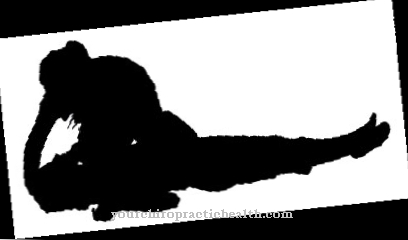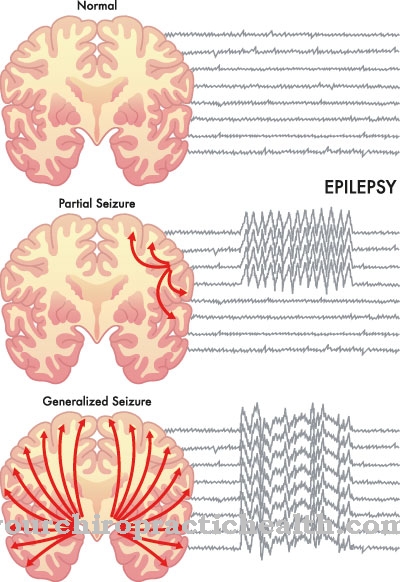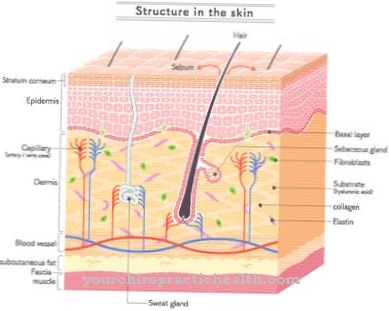The Syringomyelia is a disease of the spinal cord. Here, cavities (syringen) appear along the spinal canal, which are filled with fluid. The formation of cavities displaces and squeezes nerves, which in addition to sensory disturbances and pain can also lead to paralysis. Syringomyelia is incurable, as it can recur despite treatment.
What is syringomyelia?

The Syringomyelia is a spinal cord disease. The spinal cord is located in a bony canal, where it is washed with liquor. If the cerebrospinal fluid cannot circulate freely, the cerebrospinal fluid builds up. Due to the prevailing pressure, the liquor looks for a new path and forms cavities where the liquid collects. These cavities can form along the spinal cord as well as in the lower areas of the brain.
If the syringen are in the brain, one speaks of a syringobulbie. A distinction is made between primary and secondary syringomyelia. Primary syringomyelia is congenital and develops over the years. In the congenital variant, the cavities are filled with spinal fluid (liquor). In secondary (acquired) syringomyelia, the cavities are also filled with liquor, although the protein concentration is significantly increased here.
As a result of the cavity formation, the nerve tissue is displaced, which, depending on the severity, leads to more or less severe neurological deficits. Sensory disturbances, pain, numbness and paralysis can result. If the syringomyelia is not adequately treated, a paraplegic syndrome will inevitably develop in the further course.
causes
The Syringomyelia has several causes, depending on whether it is a primary or secondary variant.
In primary (congenital) syringomyelia, a so-called Chiari malformation is usually present. This is a malformation that is found in the transition area between the brain and the spinal cord. Here the cerebellum - also known as the medulla oblongata - is displaced into the spinal canal. The cause is a developmental disorder of the embryonic system between the fourth and sixth week of pregnancy.
Since the cerebellum is displaced and thus blocks the spinal canal, the circulation of the liquor is also disturbed. Many years can pass before a cavity (syringe) forms over time. Usually the area between the cervical and thoracic spine is affected.
Secondary syringomyelia is most often acquired as a result of an accident or injury. These are i. d. R. Injuries to the spine with involvement of the spinal cord. Clinical evaluations showed that around six percent of these cases develop syringomyelia in the following years.
Another cause of syringomyelia is inflammation of the skin of the brain or spinal cord, also known as spider skin. This inflammation is often the result of meningitis. If the skin of the spinal cord is inflamed, so-called adhesions can occur with the surrounding tissue, which impairs the flow of liquor.
Tumors in the spinal cord are another possible cause. These can also disrupt the circulation of the spinal fluid. However, combinations of the causes mentioned can also occur, especially in acquired syringomyelia.
Symptoms, ailments & signs
Depending on the location of the cavity formation in the spinal cord, syringomyelia can manifest itself through various symptoms. Typical are severe pain in the head, shoulder and arm area, which those affected describe as sharp, burning or dull. Individual areas of the skin of the extremities can be affected by sensitivity disorders, there is often a pronounced insensitivity to heat - but an increased sensitivity to cold or heat is also possible.
Occasionally, even light touches are perceived as painful, and many patients report tingling or stinging in the extremities. Furthermore, dizziness, coordination disorders and unsteady gait can occur, as well as temporary memory disorders. Other possible signs are muscle cramps, uncontrolled muscle twitching and paralysis:
Impairment of the bladder or bowel sphincter leads to urinary or fecal incontinence. The disease can lead to impaired hearing and vision, and speech can also be restricted. Sexual dysfunctions are not uncommon: While these are mainly noticeable in women through a decreased libido, men often experience erectile dysfunction up to impotence.
As the disease progresses, malformations and inflammations can develop in the head and spine area. Non-specific symptoms of syringomyelia are rapid fatigue, general weakness, insomnia, and depressive moods that can develop into depression.
Diagnosis & course
The diagnosis is made Syringomyelia using imaging techniques such as B. MRI, CT and X-ray. With the aid of contrast media, the spinal canal can be clearly visualized so that cavities can be clearly seen. Further magnetic resonance examinations can also show the CSF flow. Even the smallest changes or disturbances can be detected here.
To rule out an inflammatory cause, i. d. Usually a so-called lumbar puncture is performed. A sample of the liquor is taken from the lower area of the lumbar spine using a cannula. Before an operation is considered, a so-called myelography is often used. The CSF space is punctured under X-ray control.
After the injection of a contrast agent, x-rays are used to determine how far the spinal canal can expand. The images show whether the cavity is directly connected to the spinal canal and how it is structured.
Syringomyelia is a slowly progressing disease. Especially in the primary (congenital) variant, syringomyelia develops only slowly or can also come to a standstill and regress. In around 20 percent of all those affected, even an operation cannot stop the syringomyelia.
The syringomyelia acquired through an accident shows a strongly degenerative course, that is, it worsens continuously. The prognosis or the further course depends on the cause, especially if tumors are the trigger of the syringomyelia. In addition to damaging the nerves, the blood supply to the spinal cord is often impaired. Because of this, paraplegia is usually the result. Surgery cannot eliminate syringomyelia, but it can improve the quality of life of the person affected.
Complications
In the worst case, the syringomyelia can lead to paralysis and various sensory disorders. This paralysis is irreversible and can therefore no longer be reversed. Even with treatment, not all complaints can usually be limited. The patients suffer from severe pain due to illness.
These can occur in the back, neck and arms. The pain also spreads to other regions. Due to the sensory disturbances, there may also be restrictions in everyday life. Young people in particular can show spasticity and twitching in their muscles due to syringomyelia.
In many cases, they are teased and bullied, especially in kindergarten or school, which can lead to psychological complications or depression. Child development is also considerably restricted. The paralysis can be limited with the help of various therapies.
However, this rarely results in a completely positive course of the disease. However, life expectancy itself is not negatively affected. If a tumor has formed, it must be removed. The further course of the disease depends heavily on the success of this intervention.
You can find your medication here
➔ Medicines for painWhen should you go to the doctor?
With syringomyelia, the person concerned depends on a medical examination and treatment so that the symptoms can be alleviated. Self-healing cannot occur here either, so that the person affected is always dependent on an examination. The earlier the examination and treatment of syringomyelia is initiated, the better the further course of the disease will usually be. A doctor should therefore be consulted at the first signs and symptoms.
The doctor should be consulted if the affected person suddenly has severe visual problems. These usually occur for no particular reason and remain permanent. In the worst case, this can lead to complete blindness, although both eyes do not always have to be affected by the syringomyelia. It is not uncommon for pigment disorders or other complaints on the skin to indicate the disease and should be examined by a doctor. Usually the disease can be treated by a general practitioner or an ophthalmologist. The life expectancy of the person affected is not restricted by the syringomyelia.
Treatment & Therapy
Treating a Syringomyelia is primarily aimed at relieving symptoms. Since the disease is associated with pain from the start, adequate pain therapy should be initiated. Since syringomyelia is a creeping disease, physiotherapy and occupational therapy should be carried out from the start. Here you learn to deal with the disease and the associated neurological failures and to integrate them into everyday life.
Surgical intervention is the only option to stop the syringomyelia or to slow it down in its course. In a neurosurgical procedure, a so-called shunt (tube) is inserted into the cavity so that the fluid can drain off. However, this procedure carries some risks, as the shunt must remain in the spinal cord to ensure constant drainage. The shunt itself can also cause syringomyelia, as it can, as a foreign body, disrupt the circulation of the liquor. Furthermore, pathogens can penetrate via the shunt or wound and cause inflammation.
Another surgical procedure is the FMD (foramen magnum decompression operation). During this procedure, the opening in the skull is widened towards the spinal cord. The first two vertebral arches are removed. If a tumor is the cause of the syringomyelia, it is surgically removed. If the skin of the spinal cord is stuck together, it is surgically loosened so that the liquor can flow freely again.
With all treatment options, however, it must be taken into account that syringomyelia is incurable and can recur.
prevention
To date, no adequate measures are known to help one Syringomyelia can prevent.
Aftercare
In most cases, those affected have very few or limited options for follow-up care for syringomyelia, as it is a relatively rare disease.So that there are no other complications or complaints in the further course, the person affected should consult a doctor at an early stage.
A doctor should be contacted at the first signs or symptoms of the disease. In most cases, however, the syringomyelia causes various malformations in the child, so that the child is dependent on intensive care in their everyday life. As a rule, syringomyelia cannot be treated during pregnancy, so that the various malformations and malformations can only be corrected after the child is born.
In many cases, those affected by the syringomyelia are also dependent on the help and care of their own families. This primarily alleviates or prevents possible depression and other psychological upsets. Even after a successful procedure, regular check-ups and examinations by a doctor are very important in order to monitor the current state of the syringomyelia. As a rule, this disease does not reduce the patient's life expectancy.
You can do that yourself
Syringomyelia is not always immediately recognizable as such in everyday life. It is therefore difficult to initiate the right self-help measures. If the typical symptoms occur, the risk patients should therefore consult a doctor early on. Once diagnosed, there are a number of ways people can reduce their suffering.
While physical exertion and stress intensify the characteristic basic pain, relaxation breaks and sedative medication ensure an improvement. However, conventional drugs and neuroanalgesics often only help temporarily. Therefore, patients should be careful with physical activity and only engage in gentle sports. The adjustment of living and working circumstances is inevitable for them. Whether those affected are on their feet for a long time, sitting or lying down, they always need to change their posture. This has an unfavorable effect on everyday activities and severely restricts people. A regular daily routine is hardly possible.
This is why regular physiotherapy is required after rehab. Depending on the course of the disease and the individual situation, the doctor can prescribe psychotherapy. On the one hand, this helps the patient to accept the disease and, on the other hand, ensures a stronger self-esteem in everyday life.













.jpg)

.jpg)
.jpg)











.jpg)